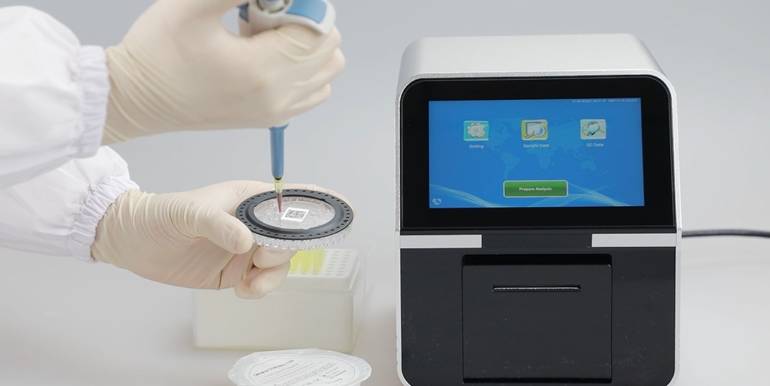ELISA-Enzyme-Linked Immunosorbent Assay is a labeled immunoassay. It is regarded as the gold standard for immunoassays. This
immunological test is very sensitive and can be used to detect and quantify substances, including antibodies, antigens, proteins, glycoproteins and hormones.
ELISA tests are very classical, long-established tests that continue to be used in clinical and basic research. Prior to the development of ELISA, the only option for performing immunoassays was radioimmunoassays, but due to the potential health risks posed by radioactivity to laboratory personnel, ELISA became a safer alternative method.
The principle of ELISA is very similar to other immunoassay techniques. The detection system then indicates the presence and amount of antigen binding.
Antibodies are proteins that are produced by an individual's immune system. This protein type can bind to an antigen in a specific region. Antigens are proteins that can be derived from certain foreign substances. When bound to an antibody, a series of signals are induced through the body's immune system. This interaction is utilized in ELISA testing, where only a small number of test samples are needed to identify specific protein antibodies and antigens.

There are four main types of ELISA as follows.
1. Direct ELISA
In a direct ELISA, protein antigens are adsorbed into the wells and rinsed to suppress the amount of unadsorbed antigen. The antigen is then detected directly by the labeled antibody.
Advantages.
-
Rapid, using only one antibody and in fewer steps.
-
Eliminates cross-reactivity of secondary antibodies
Disadvantages
-
Cell smear: non-adherent cells are adhered to the coverslip by chemical bonding
-
Immunoreactivity of primary antibodies may be adversely affected by enzymatic or labeling markers
-
Labeling primary antibodies for each specific ELISA system is time-consuming and expensive
-
Lower sensitivity due to lower density of labeled antibodies
2. Indirect ELISA
In an indirect ELISA, proteins are non-specifically adsorbed into the wells. It is called an indirect ELISA because the detection of the antigen is done in two steps by using a secondary antibody, to which an unlabeled antibody specific for the antigen is added in the first assay, and then a secondary antibody to detect the primary antibody is added.
Advantages
-
Many primary antibodies can be prepared in one species and the same labeled secondary antibody can be used in the assay.
-
Maximum immunoreactivity of the primary antibody is preserved due to the absence of labeling.
-
The high density of labeled secondary antibodies allows for high sensitivity, which leads to signal amplification.
Disadvantages
-
Cell smear: non-adherent cells are adhered to coverslips by chemical bonding.
-
Secondary antibodies may cross-react, resulting in a non-specific signal.
-
This process requires an additional incubation step.
3. Sandwich ELISA
Sandwich ELISAs usually require the use of paired antibody pairs. Each of these antibodies is specific for a different, non-overlapping part of the antigen molecule (the epitope). The first antibody (called the capture antibody) is adsorbed into the wells, and the sample solution is then added to the wells. The second antibody (called the detection antibody) measures the concentration of the sample after this step. This ELISA has the following advantages.
-
High specificity: specific capture and detection of the antigen/analyte
-
Suitable for complex or crude/impure samples: no need to purify the antigen prior to measurement
-
Flexibility and sensitivity: direct or indirect detection methods can be performed
-
However, sandwich ELISA requires two antibodies against different epitopes of the same antigen. Therefore, custom antibody development may be required.
4. Competition ELISA
Competition ELISA is a complex technique that is particularly suitable for small antigens. A competitive ELISA is primarily used to measure the concentration of an antigen (or antibody) in a sample. The principle is to detect signal output interference caused by competition between the sample antigen or antibody and a labeled binding reference (antigen or antibody). Since the signal is induced by the labeled reference, "the weaker the signal, the higher the concentration of the analyte in the sample".
Competitive ELISA is based on direct, indirect or sandwich ELISA assays. Therefore, the advantages and disadvantages are related to the chosen technique.
Applications of ELISA
ELISA has a wide range of applications. For example, rapid antibody screening tests against human immunodeficiency virus (HIV), COIVD-19 virus and other viruses, bacteria, fungi, autoimmune diseases, food allergens, blood groups, presence of progesterone hCG, laboratory and clinical studies, detection of forensic toxicology and other diagnostics.
ELISA is widely used as a screening test for HIV because of its high sensitivity. In HIV testing, an indirect ELISA-based test is often used on a collected blood or saliva sample.
Researchers at Imperial College London, UK, recently published a study in Nature on the successful development of a novel Elisa enzyme-linked immunosorbent assay technique. The enzyme in this technique is used to control the accumulation of gold nanoparticles. Ultra-low levels of protein are detected by a color change, and the results can be read with the naked eye alone, eliminating the need for expensive instruments and tedious experimental steps.
The University of Michigan, Ann Arbor and the School of Information Science at Fudan University have recently published in the journal Nature Communications a novel optical microfluidic laser enzyme-linked immunosorbent assay (ELISA) technique that they have jointly developed. This new technology will be applied to the early detection and diagnosis of major diseases such as cancer and AIDS, as well as to the study of the catalytic mechanism of individual enzyme molecules.
The technology innovation over conventional ELISA lies in the use of fluorescent products as the laser gain medium and the use of optical microcavities with high quality factors to generate laser output. At a fixed pump power, the threshold time to generate the laser is inversely proportional to the concentration of the target molecule under test. Different concentrations correspond to different threshold times, and thus, the threshold time is used as the detection signal in this technique.
The existing ELISA devices are still not sensitive enough for many clinical samples. Especially for rare samples, when the total number of protein target molecules to be measured is very small, it is important to improve the molecular counting efficiency.
A US-based diagnostic company has developed a fully automated digital, ultra-sensitive single-molecule protein assay that is capable of detecting samples with a small number of target molecules, improving the accuracy and sensitivity of the measurement. This technology is an ultrasensitive research diagnostic platform based on single-molecule immunoarray technology that is 1,000 times more sensitive to protein concentrations than existing technologies.
Researchers at the University of Michigan and diagnostic companies have developed a portable, rapid, low-cost, high-precision microfluidic ELISA device for the detection of antibodies to the new crown pneumonia. It provides quantitative and accurate results in as little as 15 minutes by taking a fingertip blood sample. This microfluidic ELISA product is lightweight, portable, and cost effective, meeting the needs of operators in this pandemic for rapid response testing.



